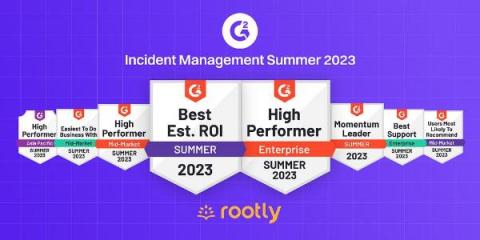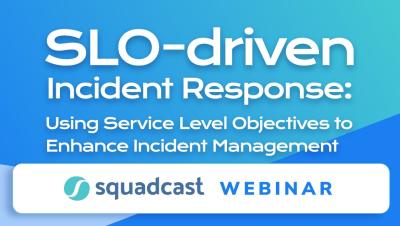Operations | Monitoring | ITSM | DevOps | Cloud
September 2023
Blameless Announces New Google Docs and Google Drive Integration to Help Engineering Teams Enhance Their Incident Management and Retrospectives
Unveiling Past Incidents: Accelerating Incident Resolution with Historical Context
Product Spotlight: Enhancing Incident Resolution with Blameless' Microsoft Teams Integration
Status Pages 101: Everything You Need to Know About Status Pages
Status Pages are critical for effective Incident Management. Just as an ill-structured On-Call Schedule can wreak havoc, ineffective Status Pages can leave customers and stakeholders, adrift, underscoring the need for a meticulous approach. Here are two, Matsuri Japon, a Non-Profit Organization and Sport1, a premier live-stream sports content platform, both integrate Squadcast Status Pages to enhance their incident response strategies discreetly. You may read about them later. Crafting these Status Pages demands precision, offering dynamic updates and collaboration.
The Ultimate Guide to DORA Metrics for DevOps
In the world of software delivery, organizations are under constant pressure to improve their performance and deliver high-quality software to their customers. One effective way to measure and optimize software delivery performance is to use the DORA (DevOps Research and Assessment) metrics. DORA metrics, developed by a renowned research team at DORA, provide valuable insights into the effectiveness of an organization's software delivery processes.
OpenTelemetry vs. OpenTracing
OpenTelemetry vs. OpenTracing - differences, evolution, and ways to migrate to OpenTelemetry.
Bill Kennedy: The mistake boot, building ACs, Black boxes & AI in software - The Reliability Podcast
Top 5 Resiliency Trends of 2023
In today’s world, resilience is no longer a conditioned desire or methodology to try but has become a necessity for sustained success in software development and IT operations. As DevOps and Agile teams keep moving forward to cross boundaries, come up with new methodologies, and drive innovation, it is now important to have the ability to quickly recover from failures, adapt to changing conditions, and maintain high performance under pressure.
Mastering Incident Resolution: Process and Best Practices
Implementing Zero Trust: A Practical Guide
Streamlining Incident Management with our latest feature update: Merge Incidents
Journey from Junior to Senior SRE: Key Insights and Strategies
As Site Reliability Engineering (SRE) continues to grow in popularity, many professionals are looking for ways to advance from junior to senior roles. While there is no one-size-fits-all approach, the transition from junior to senior SRE is marked by a gradual increase in experience and a set of key skills. In this blog, we will explore the valuable insights and strategies shared by experienced SREs.
What's the Difference Between an Agile Retrospective and an Incident Retrospective?
Elastic AI Assistant for Observability
Blameless Garners Acclaim in Industry Reports from G2 and Gartner for Site Reliability and Incident Management
Seven Models of Cloud Native Applications
Webinar: Internals of How we tame High Cardinality
Webinar: Uncovering High Cardinality with Piyush Verma
How to Set Up an IT War Room
IT issues can happen at any time and significantly impact an organization. Hence, it's essential to have a plan to handle these issues quickly and efficiently. And one way to do this is to create an IT war room. An IT war room is a dedicated space for teams to collaborate and resolve issues. Establishing an IT war room enhances an organization's capacity to swiftly and efficiently address IT problems, ultimately reducing their impact on the business.
Enhancing Incident Management: Seven Integrations to Complete Your Ticketing Systems
Practical guidance for getting started as a site reliability engineer
At the beginning of May, I joined incident.io as the first site reliability engineer (SRE), a very exciting but slightly daunting move. With only some high-level knowledge of what the company and its systems looked like prior to this point, it’s fair to say that I didn’t have much certainty in what exactly I’d be working on or how I’d deliver it.
Blameless Announces New CommsFlow Upgrade to Elevate Incident Management Communication
This arctic winter - time to repay your tech debt
We're in a peak tech winter. What should engineering teams focus on when product velocity dwindles?
Celebrating Our Nine New G2 Awards
We’re proud to share that we've been recognized as a High Performer and Enterprise Leader in Incident Management for the sixth consecutive quarter in the G2 Summer 2023 Report! In total, Rootly received nine G2 awards in the Summer Report.
SLO Driven Incident Response: Service Level Objectives for Effective Incident Management | Squadcast
Observability vs Monitoring: What's the Difference?
Observability and monitoring: These terms are often used interchangeably, but they represent different approaches to understanding and managing IT infrastructure. If you are new to these terms or are often confused between the two, this blog is for you! In this blog, we'll explore the key concepts of observability and monitoring, their evolution in IT operations, their differences and similarities, and their importance in modern infrastructure.



























